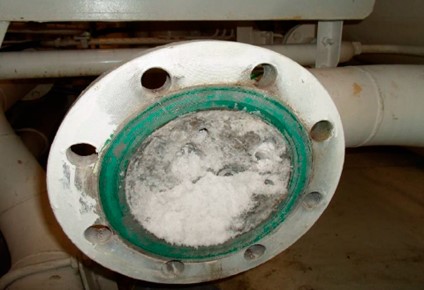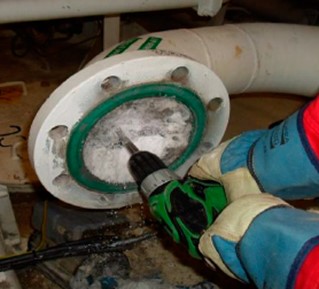Loading started and the crew soon noticed that no cargo was received and suspicion arose that the line might be blocked.
To assess the problem a dismantling of the load line was commenced and it was proved that the brine had turned into a crystallized white mass and had in some places been completely packed inside the loadline.


The opened lines revealed a crystallized white mass that blocked the system.
How could this happen?
The cargo is referred to as Brine, whether it is Sildril or Calcium Chloride. Moreover, both types of cargo are considered harmless. The crew then handled Sildril as a “Brine-like material”, and got instruction to clean tanks and systems upon cargo unloading. However, the design of the Brine line system with the crossover line was such that a cleaning “to Brine standard” was insufficient for the Sildrill type of cargo, which requires the system to be completely clean prior to taking on board for instance Calcium Chloride.
Company investigation revealed a highly unwanted and perfect reaction between two chemically distinct substances. The outcome of the chemical reaction resulted in clogged brine loading systems. It was identified to be the remainders of Sildril in the pipes, which contaminated the cargo of Calcium Chloride Brine to be loaded.
Consequence #1 - The material consequences
Disruption of loading for examination of lines, cancellation of loading operation, and cleaning of cargo lines which took altogether 9 days.
Consequences #2 - The consequences on the health condition of the personnel involved
The shipboard personnel involved in the dismantling of the line system and clearing parts of it for the clogged brine reported a series of physical discomfort, such as: - nausea, - fatigue - respiratory problems, - discoloured (darkened) urine, - and kidney pain. The aggregate effect resulted in sick leave for four of the personnel involved in the cleaning operations.
Actions
When realizing and reporting coinciding physical discomfort and symptoms, the master stopped the work on the brine lines and reported the situation and concern to the Company vessel manager. An investigation together with the Charterer was then conducted on the incident.
The Company HSEQ Policy clearly states that:
Everyone has the obligation to stop or delay activities that may place him/her or others at risk of being injured, or which could lead to damage to the environment or equipment.
It seems that all mechanisms to that effect were ‘turned off’ due to the above-mentioned understanding regarding the harmlessness of this cargo.
Corrective actions proposed
Short-term corrective actions personnel, procedures & barriers
Improved communication / Instruction programme
- In order to ensure improved shipboardcomplement awareness regarding cargo properties.
Improved washing procedures
- “Brine standard” is one, complete cleaning is another.
Clearer cargo handling procedures
- Update of the cargo handling procedures
Cleaning by outside personnel
- Should the shipboard personnel undertake the cleaning or should it be handed over to outside personnel?
- If shipboard personnel undertake the cleaning operation, then the vessel must be supplied with the correct breathing protection for any type of cleaning jobs, if/when required.
Long-term Actions
Improved communication Logistics Dep. / shipboard management
- It is obviously not possible to bring the chemical proficiency of the shipboard management up to the level of the chemists in the Logistics Department onshore. Proper communication with the onshore Departement would therefore be key in gaining complete information to prevented similar occurrences.
The human element – enhanced safety awareness
- The Company will follow up with awareness and attitude training by calling personnel to the office, followed by subsequent sessions on board with all personnel involved.
Enhanced risk assessment process
- The Company risk assessment format has been expanded to include the element Measures of Mitigation.
